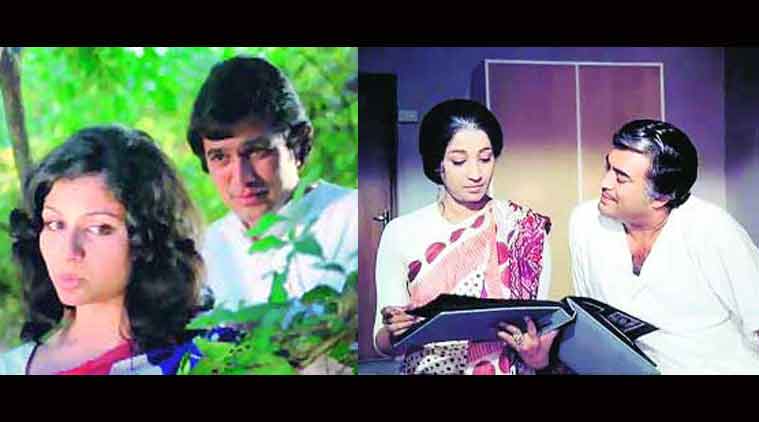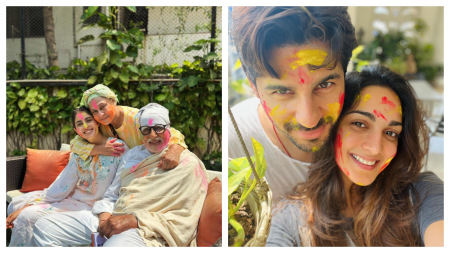- India
- International
Sacrificed at the Altar
There are few Hindi films that deal with the real pain of marital estrangement.
 Troubled times Rajesh Khanna and Sharmila Tagore in Aavishkar; Suchitra Sen and Sanjeev Kumar in Aandhi.
Troubled times Rajesh Khanna and Sharmila Tagore in Aavishkar; Suchitra Sen and Sanjeev Kumar in Aandhi.
There are few Hindi films that deal with the real pain of marital estrangement.
Some wise person once said: the loneliest place can be the bed even when there are two people in it.
I would qualify that by describing those two people — who are, or have been, in a marital or otherwise, deep relationship which once meant the world, and which now seems like a cracked mirror, refracting and twisting once beloved images; two people who now are left in their separate corners wondering, when they can get past the anger and bitterness, whatever happened to us?
The do-dil-ek-jaan construct that founders in the face of harsh reality is something I’d brought up a few months back in a column on “spousality and marriage”, looking at some of my favourite non-Hindi films. What about Bollywood, I was asked at that point.
So here is a quick reckoner on the happily-ever-after in Hindi cinema. Why there are so few films which deal with what happens after the holy trinity of mandap-mangalsutra-marriage is evident: our movies still deal, largely, with girls and boys who sing to each other about being “solah” and “satrah baras” in the first flush of love.

Because marriage and what comes after is whole different thing: till the time you sweep up to the altar, everything about the person you are getting into wedlock with is enchanting. After a while, when the can’t-keep-hands-off-each-other stage passes, and wet towels left on beds and pointed barbs getting mixed in the billing-and-cooing become the norm, the two people realise, shit, THIS is what we have to deal with?
New-age Bollywood has struggled with this theme, using it fleetingly or not at all. Karan Johar, the director who makes all things zardozi-and-splashy, has broken out in a lovely segment in Bombay Talkies, which focuses on a couple who have nothing going on. He had attempted the same thing in Kabhi Alvida Na Kehna, and despite the film’s lushness, there were some startlingly true scenes of troubled people occupying compromised, broken marital spaces. In fact, the KANK leads, Shah Rukh Khan and Rani Mukherji, had played out an angry couple in an earlier film called Chalte Chalte, but both these films had to overlay their ugliness with faux jollity: the real pain of estrangement in Hindi films harks back to an older era.
Basu Bhattacharya was called, quite justifiably, Hindi cinema’s “marriage specialist” because his films dared to deal with the pain that two humans can cause each other, often quite deliberately. In Anubhav, an old flame crops up between searching-for-intimacy Sanjeev Kumar and Tanuja. In Aavishkar, strife occurs between comely couple Rajesh Khanna and Sharmila Tagore. In Grihapravesh, the last of the “marriage trilogy”, he takes Sanjeev Kumar and Sharmila Tagore, and puts them alongside Sarika, and shows how discord can destroy.
All these films came out in the ’70s when it was quite all right for our movies to carve out middle-of-the-road realism and still expect to be watched. Gulzar picked up the relationship thread, and ran with it. His Aandhi may have had a strong political vein, but was at its heart the interplay between an estranged couple. Much before that one, there was Ijaazat, in which a chance meeting between Naseerudin and Rekha unleashes a storm of suppressed emotions. The film, like all Gulzar’s films, had lovely music, and gave us an inside view of that most opaque thing: the stuff that keeps two people yearning in their hearts even when they have been physically separate for years.
An unreleased film that Gulzar made just after Ijaazat, which I had the chance to see at last November’s IFFI in Goa, is a true find. Libaas means clothing. It could also mean aavaran: layers that we clothe ourselves in, and refuse to see what lies underneath when we are stripped of them, because it is much too agonising. The film puts Naseer and Shabana in a marriage gone sterile, and brings in infidelity: not in the half-hearted, pussy-footing way Hindi cinema deals with this tricky subject, but in a full-throttle manner, that brings men and women and desire to the fore and gets them to a roiling boil. Extramarital affairs are as commonplace as marriages, and adultery can be as much about thinking as doing. Many years later, Govind Nihalani’s Drishti had Shekhar Kapoor and Dimple Kapadia traverse this minefield with acuity.
The beauty of Libaas unspools in the way in which the husband, played by Naseer, makes the adulterous couple (Raj Babbar is the unexpected other man) realise that he knows about them, without railing. There is guilt, yes, but there is no melodrama. Gulzar paints a searing picture of a couple that began with some kind of love, and progressed into those separate corners of their bed, searching for a semblance of equanimity.
Maybe that’s not what they had planned on, or dreamt of. Just like life itself.
Click for more updates and latest Bollywood news along with Entertainment updates. Also get latest news and top headlines from India and around the world at The Indian Express.
Photos
Apr 25: Latest News
- 01
- 02
- 03
- 04
- 05










































